Palm Islands
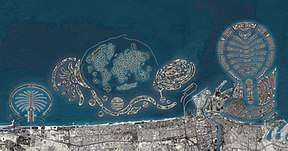
Palm Islands are three artificial islands, Palm Jumeirah, Deira Island and Palm Jebel Ali, on the coast of Dubai, United Arab Emirates. Creation of the islands started in 2001. As of November 2011, only Palm Jumeirah has been completed. This island takes the form of a palm tree, topped by a crescent.
After completion, Palm Jebel Ali will take a similar shape. Like Palm Jumeirah, each island will be host to a large number of residential, leisure and entertainment centers and will add a total of 520 kilometers of non-public beaches to the city of Dubai.
Palm Jumeirah
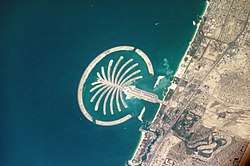
The Palm Jumeirah (Coordinates: 25°06′28″N 55°08′15″E / 25.10778°N 55.13750°E) consists of a tree trunk, a crown with 16 fronds, and a surrounding crescent island that forms an 11 kilometer-long breakwater. The island itself is five kilometers by five kilometers. It adds 78 kilometers to the Dubai coastline.
Residents began moving into Palm Jumeirah properties at the end of 2006, five years after land reclamation began.
Palm Jumeirah Monorail opened in 2009; it is connected to station 9 of the Dubai Tram (Palm Jumeirah Station).
Palm Jebel Ali

The Palm Jebel Ali began construction in October 2002 and it was supposed to be completed by October mid-2008 but has been on hold since.Palm Jebel Ali was going to be built much larger than palm Jumeirah but unfortunately it was never completed.[2][3]
Environmental concerns
The construction of the Dubai Palm Islands has had a significant impact on the surrounding environment, resulting in changes to area wildlife, coastal erosion, alongshore sediment transport and wave patterns. Sediment stirred up by construction has suffocated and injured local marine fauna and reduced the amount of sunlight which filters down to seashore vegetation. Variations in alongshore sediment transport have resulted in changes in erosion patterns along the UAE coast, which has also been exacerbated by altered wave patterns as the waters of the Persian Gulf attempt to move around the new obstruction of the islands. [4][5]
Dubai's megaprojects have become a favourite cause of environmentalists. Greenpeace has criticized the Palm Islands for lack of sustainability, and Mongabay.com, a site dedicated to rain forest conservation, has attacked Dubai's artificial islands aggressively, stating that:
Significant changes in the maritime environment [of Dubai] are leaving a visual scar [... ] As a result of the dredging and redepositing of sand for the construction of the islands, the typically crystalline waters of the Persian Gulf at Dubai have become severely clouded with silt. Construction activity is damaging the marine habitat, burying coral reefs, oyster beds and subterranean fields of sea grass, threatening local marine species as well as other species dependent on them for food. Oyster beds have been covered in as much as two inches of sediment, while above the water, beaches are eroding with the disruption of natural currents.[6]
Structural importance
Palm Jumeirah was built entirely from sand and rocks (no concrete or steel was used to build the island). This was done in accordance with the order of the Ruler of Dubai, who came up with the idea for the Palm Islands, as well as their design.[7]
Construction resources involved
- 5.5 million cubic metres of rock brought from over 16 quarries in Dubai.
- 94 million cubic metres of sand brought from deep sea beds 6 nautical miles from the coast of Dubai.[8]
- 210 million cubic metres of rock, sand and limestone
Main constraints
An important constraint was that the time estimated for completion of the project (4 years) was too long. To make the construction process on top of the island faster; 40,000 workers were hired working at 2 different shifts per day (Each shift was 12 hours).
Project risks and threats
- Waves 2 meters high.
- Storm frequency of 1 in 1 year.
- Weak soil due to constant exposure to rising sea water.[9]
- Water pollution.
Hidden problems
- Erosion (caused by winds and water currents) is one of the biggest problems present, as it strips away the sand which forms the majority of the island.
- Damage to the marine ecology (e.g. the loss of reefs and fish), including disturbances in the reproductive cycles of the species of fish that were close to the shores of Dubai. Research conducted by marine biologists on this phenomenon showed that the newly-born fish were not able to survive in conditions along the shores of Dubai due to constant construction and environmental alterations (e.g. shifting of sand, moving boulders and the effects of the vibrations).
- Due to the shape of the island right outside the coast of Dubai, there is loss of coastal shape along the seashore of Dubai.[10]
Obstacles after the island construction
Installation of utilities and pipelines were very difficult and laborious.[11]
Risk mitigation
To counteract with the waves and the constant motion of the sea, breakwaters were built all around the island. They were 3 meters high and 160 kilometers in total length. Expanded over a length of about 11.5 kilometers, the base of these breakwaters and the island itself were constantly monitored during construction process with the help of deep sea divers. The divers checked the alignment and placement of the rocks beneath the surface to ensure its stability. Shape of the island was monitored using the global positioning system (the satellite was placed about 676 kilometres from sea level into space). The sand on top of the island was sprayed by a technique called rainbowing.[12] Here the sand from the dredging ships was sprayed on to the land. The whole island was planned such that there was no stagnant water between the island and the breakwaters. In order to achieve this, small structural modifications were made to the breakwaters that surrounded the island, allowing the sea water to move through the breakers without causing any damage to the island.[13] To prevent erosion of the sand from the island, maintenance systems spray material along the coast of the island and also along the Dubai coast. Coastal ecology was recovered with the help of nature itself. These changes began attracting newer species of fishes and also reef formations. Every 6 weeks sea divers go down under water to check the marine life as part of their monitoring process. Precautions were also taken to prevent the process of liquifaction of the sand on the island (below the upper surface). This process of liquifaction was caused by the movement of the rocks and sand and also underwater erosion before and after construction. A Vibro-compaction technique was used to prevent the process of liquifaction.[14] This was carried out in order to hold the island's base together and also to make a strong foundation for further construction.[15]
Construction effects and repercussions
The construction of the Palm islands along the coast of Dubai has caused several large environmental changes: a reduction in the area's aquatic life, erosion of the coastal soil, and irregular sediment transport along the shore. There is also a dramatic change in wave patterns along the coast of Dubai due to the rock walls constructed around the palm islands: instead of hitting the shores directly, the waves move in an unusual manner around the new obstruction. This has led to the weakening of the shores of Dubai.[16]
Most of the environmental damage was caused by the sediments stirred up by the construction; it suffocated and injured the surrounding marine fauna and decreased the amount of sunlight filtering down to the sea vegetation.[17] Such environmental disturbances have turned the heads of many environmental activists. Greenpeace and Mongabay.com (Rain forest conservation organization) have expressed very strong opinions against the building of the Dubai Palm islands.
The World Wildlife Fund announced in 2006, "[The] UAE's human pressure on global ecosystems (its ecological footprint) [is] the highest in the world. The country is supposedly at present five times more unsustainable than any other country" (Samarai 2007). It also mentioned that the construction from the start up to date had caused many visible ecological and environmental changes that were a threat to the future.
Remedial measure to protect the coast
To properly manage their shorelines and effects, Dubai relies on its coastal monitoring program. Established in 1997, the Dubai coastal monitoring program began studying the baseline bathymetric (measurement of depth of water in oceans or seas) and topographic survey of the Jumeirah (Dubai) coastline.
Additional data were collected with technological improvements including remote video monitoring of Dubai beaches, sediment sampling and analysis, near shore directional wave and current recordings and intensive measurement exercises at selected locations using Acoustic Doppler Current Profiler (ADCP) equipment. This way they were able to do a constant monitor and check on the continuously changing environmental conditions along the coast of Dubai.[18]
Gallery
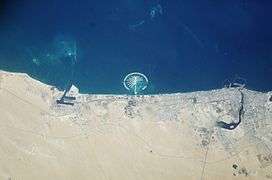
 Fronds in 2007
Fronds in 2007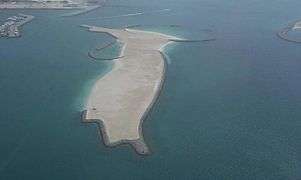
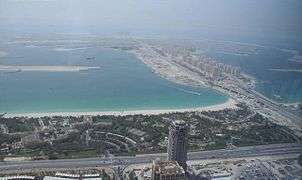

 Jumeirah core
Jumeirah core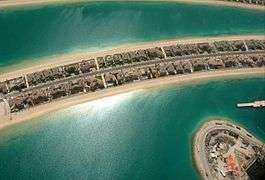 Frond, 2008
Frond, 2008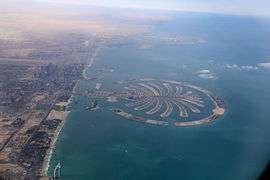 Aerial view, March 2015
Aerial view, March 2015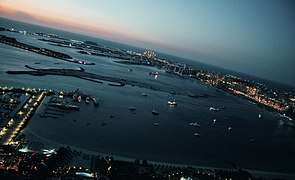 View of Palm Jumeirah, 2015
View of Palm Jumeirah, 2015
Geo Links
Ideally Geo Links should be integrated into the main article.
- 25°06′56″N 55°07′57″E / 25.115601°N 55.132484°E Satellite view of The Palm Islands
- 25°00′N 54°59′E / 25.000°N 54.983°E The Palm Jebel Ali
- Maps 25°07′00″N 55°08′00″E / 25.11667°N 55.13333°E Palm Jumeirah
See also
- The World, another artificial island project in Dubai.
- Nakheel, the real estate developer of Palm Islands
- Tourism in Dubai
- Ocean colonization
- Tourist attractions in Dubai
References
- ↑ "YouTube - The Palm Island, Dubai UAE - Megastructure Development". youtube.com. Retrieved 2014-01-25.
- ↑ "The Palm Jebel Ali (Palm Islands, Dubai) - Property Development". The Emirates Network: Ten Real Estate. 2007. Retrieved 2007-02-11.
- ↑ "Dubai's Palm and World Islands - progress update". AMEInfo. 4 October 2007. Archived from the original on 11 October 2007. Retrieved 2007-10-28.
- ↑ "Environmental Impacts of Palm Islands". Sites.google.com. Retrieved 4 October 2017.
- ↑ "Dubai's Artificial World Islands Are Killing Corals and Pushing Nature Out of the Sea". Greenprophet.com. Retrieved 4 October 2017.
- ↑ "Dubai's artificial islands have high environmental cost". News.mongabay.com. Mongabay. Retrieved 4 October 2017.
- ↑ "Dubai Palm Island | HQ Travel Guide". hqtravel.net. Retrieved 2014-01-25.
- ↑ "Construction of the Islands - The Impact of the Palm Islands, United Arab Emirates". sites.google.com. Retrieved 2014-01-25.
- ↑ "HowStuffWorks "Palm Island Construction"". adventure.howstuffworks.com. Retrieved 2014-01-25.
- ↑ "The World is sinking: Dubai islands 'falling into the sea' - Telegraph". telegraph.co.uk. Retrieved 2014-01-25.
- ↑ "Palm Island Dubai – Palm Tree Island Megastructure Construction". Enggpedia. Retrieved 2014-01-25.
- ↑ "Palm Islands, Dubai — 8th Wonder Of The World | Prime Arena". eb.archive.org. Archived from the original on 2013-07-22. Retrieved 2014-01-25.
- ↑ "Palm Islands, Dubai - Compression of the Soil". cdmsmith.com. Retrieved 2014-01-25.
- ↑ "The Palm - Design Build Network". designbuild-network.com. Retrieved 2014-01-25.
- ↑ "Engineering Challenges: Palm Island". engineeringchallenges.blogspot.com. Retrieved 2014-01-25.
- ↑ "Will the Gulf’s manmade islands sink into the sea? - Your Middle East". yourmiddleeast.com. Retrieved 2014-01-25.
- ↑ Bayyinah Salahuddin. "The Marine Environmental Impacts of Artificial Island Construction Dubai, UAE" (PDF). Dukespace.lib.duke.edu. Retrieved 4 October 2017.
- ↑ "Environmental Impacts - The Impact of the Palm Islands, United Arab Emirates". sites.google.com. Retrieved 2014-01-25.
External links
| Wikimedia Commons has media related to Palm Islands. |
- The Palm official website
- "TOP TEN AMAZING MAN MADE ISLANDS". amiced.com. Retrieved 2014-01-25.
- Images + Information on Palm Island
- Timelapse animation of Palm Islands construction
- Dubai's Palm Islands - slideshow by The First Post
- Globalisation and Development: A Case Study of Dubai's Jumeriah Palm Island Mega Project PhD thesis by Ibrahim Abdul Rahman al Darmaki for the University of South Hampton